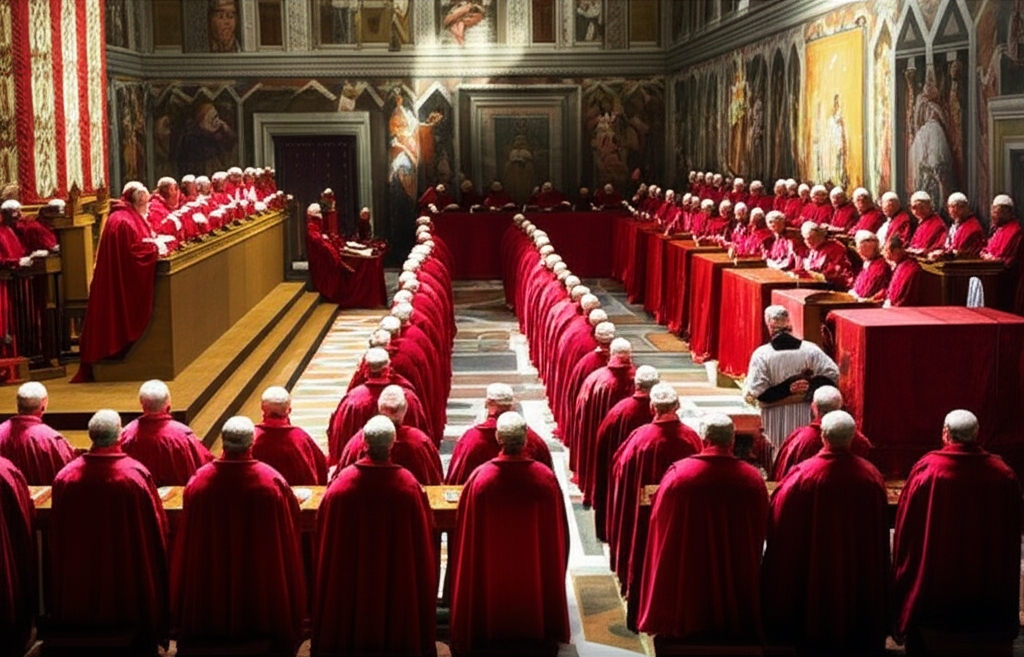
What is a Conclave?
A conclave is a meeting of the cardinals of the Roman Catholic Church to elect a new pope following the death or resignation of the previous pope. The word "conclave" comes from the Latin "cum clave" meaning "with a key," referring to the practice of locking the cardinals within an enclosed area until they reach a decision.
History of the Conclave
The practice of the conclave began in the 13th century after a particularly lengthy papal election in Viterbo (1268-1271) that lasted nearly three years. Frustrated with the cardinals' inability to elect a new pope, the townspeople eventually locked the cardinals inside the papal palace and even reduced their food to hasten their decision.
In 1274, Pope Gregory X formalized the conclave system in the apostolic constitution "Ubi Periculum," which established the basic rules that are largely still followed today. Over the centuries, the conclave procedures have been refined by various popes, with the last significant changes made by Pope John Paul II in the apostolic constitution "Universi Dominici Gregis" in 1996.
The Modern Conclave Process
The modern conclave begins no more than 20 days after the papal seat becomes vacant. All cardinals under the age of 80 (cardinal electors) gather in Rome to participate. The process includes:
1. Preparation
The cardinals hold general meetings called "general congregations" to discuss Church matters and get to know one another. The Sistine Chapel is prepared with tables and chairs for the cardinals, and electronic equipment is swept to ensure secrecy.
2. Opening of the Conclave
The conclave begins with a Mass "Pro Eligendo Romano Pontifice" (For the Election of the Roman Pontiff) in St. Peter's Basilica. Then, the cardinals process to the Sistine Chapel while singing "Veni Creator Spiritus" (Come, Creator Spirit), invoking the guidance of the Holy Spirit.
3. Oath and Closure
Each cardinal takes an oath to follow the conclave rules and maintain secrecy. After this, the Sistine Chapel is closed to outsiders with the famous announcement "Extra omnes" (Everyone out), and the conclave officially begins.
4. Voting
The cardinals conduct up to four votes per day: two in the morning and two in the afternoon. Each cardinal writes the name of their choice on a ballot paper, folds the paper, and places it into a chalice on the altar while reciting an oath.
5. Counting the Votes
Three randomly selected cardinals (scrutineers) count the votes and announce the results. To be elected pope, a cardinal needs two-thirds of the votes plus one. If there is no majority, the ballot papers are mixed with special chemicals and burned.
6. Smoke and Results
The results of the voting are communicated to the outside world through smoke from a chimney installed on the roof of the Sistine Chapel:
- Black smoke (fumata nera) means no pope has been elected
- White smoke (fumata bianca) means a new pope has been elected
7. Acceptance and Announcement
The elected cardinal is asked if he accepts the election and what name he wishes to use as pope. Upon acceptance, he immediately becomes Pope. The cardinal protodeacon then appears on the balcony of St. Peter's Basilica and announces "Habemus Papam" (We have a Pope), followed by the first appearance of the new pope who gives the "Urbi et Orbi" (To the City and the World) blessing.
Secrecy and Traditions
The conclave is known for its strict secrecy. The cardinals take an oath not to reveal what happens during the conclave, under threat of excommunication. They stay at the Casa Santa Marta in the Vatican during the conclave and are not allowed to communicate with the outside world.
Some interesting traditions include the sweeping of the Sistine Chapel for listening devices, the preparation of clothes for the new pope in three different sizes (small, medium, large), and the ritual of the "first adoration" where the cardinals pay homage to the newly elected pope.
Famous Conclaves in History
Some of the most famous conclaves in history include:
- The 1268-1271 Conclave: The longest conclave in history, lasting nearly three years
- The 1799-1800 Conclave: Held in Venice during the French occupation of Rome
- The 1939 Conclave: Elected Cardinal Eugenio Pacelli as Pope Pius XII at the beginning of World War II
- The 1978 Conclaves: Two conclaves in one year following the deaths of Pope Paul VI and then Pope John Paul I after only 33 days in office
- The 2013 Conclave: Elected Cardinal Jorge Mario Bergoglio as Pope Francis following the rare resignation of Pope Benedict XVI
Conclaves in the Modern Era
While the traditions of the conclave have remained largely unchanged for centuries, some adjustments have been made for the modern era. Pope John Paul II introduced better accommodations for the cardinals, and Pope Benedict XVI changed the rules to always require a two-thirds majority for election, removing the possibility of switching to a simple majority after several rounds of voting.
The conclave remains one of the most mysterious and fascinating rituals in the Catholic Church, combining ancient traditions with the weighty responsibility of choosing a spiritual leader for more than a billion Catholics worldwide.
Artikel atau doa ini dapat disalin dan disebarluaskan dengan syarat mencantumkan sumber artikel dari www.doa-katolik.com
Artikel atau doa ini dapat disalin dan disebarluaskan dengan syarat mencantumkan sumber artikel dari www.doa-katolik.com